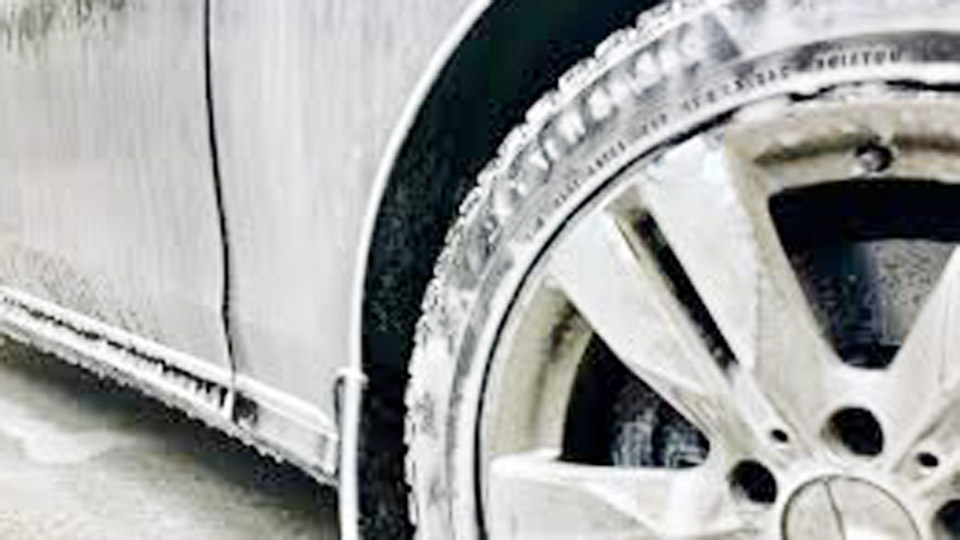How to Hand Wash a Car Without Scratching?
I’ve been a car enthusiast for as long as I can remember, spending countless weekends polishing my vehicles and learning the art of car care. There’s nothing like the satisfaction of a freshly washed car gleaming in the sunlight.
But I’ve also learned the hard way that washing a car improperly can leave scratches that dull its shine. So, how do you hand wash a car without scratching? After years of trial and error, I’ve perfected a scratch-free method that keeps my cars looking showroom-ready.

Photo by smartservice
This guide shares everything I’ve discovered, from the right tools to the best techniques, so you can clean your car safely and effectively. Let’s get started and make your ride sparkle without a single swirl mark!
Why Hand Washing Matters
| # | Preview | Product | |
|---|---|---|---|
| 1 |

|
Stoner Car Care 92604 Waterless Wash Car Detailing Spray – Safe, Scratch-Free Formula Quickly... | Check Price on Amazon |
A clean car isn’t just about looks—it’s about pride and protection. I love the feeling of sliding into a spotless vehicle, and a good wash helps maintain its value. Automatic car washes are convenient, but I’ve seen them leave swirl marks and scratches on my sedan’s paint. Hand washing gives you control, letting you clean gently and thoroughly.
It’s also a chance to inspect your car for dings or chips. I once found a small scratch while washing that I fixed before it got worse. Done right, hand washing keeps your car’s paint flawless and your wallet happy.
Scratches and How They Happen
Scratches happen when dirt or debris gets dragged across your car’s paint. I made the mistake early on of washing my truck with a dirty sponge, and the tiny scratches were heartbreaking. Even soft brushes or cloths can cause swirls if they trap grit.
Your car’s clear coat, the protective layer over the paint, is delicate. Harsh soaps, rough tools, or improper techniques can damage it. I’ve learned that preventing scratches is all about minimizing friction and keeping everything clean. With the right approach, you can wash your car without leaving a mark.
Tools You’ll Need for a Scratch-Free Wash
The right tools make all the difference. I’ve wasted money on cheap sponges that scratched my paint, so here’s what I use now:
- Two buckets with grit guards: One for soap, one for rinsing, to trap dirt.
- Car wash soap: I use Meguiar’s Gold Class or Chemical Guys Mr. Pink—gentle and sudsy.
- Microfiber wash mitts: Soft and safe for paint. I keep two for different areas.
- Hose with adjustable nozzle: For controlled rinsing.
- Microfiber drying towels: To prevent water spots.
- Wheel cleaner and brush: For tires and rims.
- Clay bar (optional): To remove contaminants like tar.
- Foam cannon (optional): For extra foam and less scrubbing.
I spent about $50-$75 on my setup, but it’s lasted years. Grit guards and microfiber mitts are must-haves to avoid scratches.
Step-by-Step Guide to Hand Washing Your Car Without Scratching
I’ve washed my cars hundreds of times, and this process keeps them scratch-free. It’s simple, effective, and works for any vehicle, from a compact to an SUV. Follow these steps, and your car will shine like new.
Step 1: Park in the Right Spot
Wash your car in the shade or early morning. I learned this after washing in direct sun, and the soap dried fast, leaving spots. Heat can make water evaporate quickly, causing streaks. I park in my garage or under a tree to keep the surface cool. Make sure the car’s surface isn’t hot to the touch before starting.
Step 2: Pre-Rinse the Car
Rinse your car with a hose to remove loose dirt, dust, or mud. I use a gentle spray, working from top to bottom. Start with the wheels—they’re the dirtiest. This step prevents grinding debris into the paint when you wash. I once skipped rinsing and ended up with tiny scratches from road grit. A pressure washer (1200-1500 PSI) is great if you have one, but a hose works fine.
Step 3: Use a Foam Cannon (Optional)
A foam cannon is my secret weapon. I attach it to my pressure washer and spray thick foam over the car. The foam lifts dirt without scrubbing, reducing the chance of scratches. I let it sit for 2-3 minutes to loosen grime. On my truck, this removed bug splatter without touching the hood. If you don’t have a foam cannon, skip to the next step.
Step 4: Wash with the Two-Bucket Method
Fill one bucket with car wash soap and water, the other with plain water. I dip my microfiber mitt in the soapy bucket, wash a small section—like the hood—then rinse the mitt in the clean water bucket. This traps dirt so it doesn’t scratch the paint. Wash from top to bottom in straight lines, not circles, to minimize swirls. I use light pressure and let the soap do the work. Work in sections to keep the soap from drying.
Step 5: Clean Wheels and Tires Separately
Wheels are filthy with brake dust and road grime. I use a dedicated wheel cleaner and a soft brush to scrub them. Don’t use the same mitt as the body—it’ll pick up grit. I rinse thoroughly to avoid residue. Clean wheels make the car look polished, and keeping them separate protects the paint.
Step 6: Rinse Thoroughly
Rinse the car with a steady stream from the hose, top to bottom. I make sure all soap is gone to prevent streaks. Use a gentle spray to avoid splashing dirt back onto the car. I check under mirrors and door handles, where soap can hide. A clean rinse sets you up for a spotless finish.
Step 7: Dry with Microfiber Towels
Drying prevents water spots, especially on dark cars. I pat the surface with microfiber towels, not dragging them. Dragging can cause swirls if any dust is left. I use multiple towels—one for the body, one for windows. It takes 10-15 minutes, but the result is a flawless shine. I once air-dried my car, and the water spots were a nightmare to remove.
Step 8: Clay Bar (Optional)
For extra smoothness, I use a clay bar every few months. Spray a lubricant on the paint and glide the clay over it—it removes contaminants like tar or sap. The surface feels like glass afterward. I did this on my sedan, and it made the paint pop. Be gentle to avoid marring the clear coat.
Step 9: Wax or Seal (Optional)
Waxing protects your paint and enhances shine. I apply a carnauba wax or sealant with a foam applicator in thin layers. Buff it off with a microfiber cloth. I use Turtle Wax Hybrid Solutions—it’s easy and lasts months. This step isn’t required every wash, but I do it every 2-3 months to keep scratches at bay.
Common Mistakes to Avoid
I’ve made plenty of blunders washing cars. Here’s what not to do to keep your paint scratch-free:
- Using dish soap: It strips wax and dries paint. I did this once, and my car looked dull.
- Washing with a dirty mitt: Rinse your mitt often. I scratched my hood early on with a gritty mitt.
- Scrubbing hard: Too much pressure causes swirls. I let the soap lift dirt instead.
- Using one bucket: Dirt gets trapped and scratches paint. The two-bucket method is a must.
- Washing in sunlight: Heat dries soap fast, leaving spots. I always find shade.
Best Products for Scratch-Free Washing
I’ve tested dozens of products, and some are game-changers. Here’s a table of my top picks:
| Product | Best For | Why I Like It |
|---|---|---|
| Meguiar’s Gold Class Soap | General washing | Sudsy, gentle, and safe for all paints. |
| Chemical Guys Mr. Pink | Foam cannon use | Thick foam, pH-balanced, and scratch-free cleaning. |
| Gyeon Q2M Bathe | Luxury cars | Slick formula reduces friction, perfect for delicate clear coats. |
| Griot’s Garage Microfiber Mitt | Washing | Super soft, holds soap well, and traps dirt safely. |
| The Rag Company Drying Towel | Drying | Absorbent, soft, and prevents water spots. |
These are available at auto stores or online. I always test products on a small area first.
How Often Should You Hand Wash Your Car?
I wash my car every two weeks to keep dirt from bonding to the paint. If you drive daily or live in a dusty area, weekly washes are better. In snowy climates, like Michigan, wash after snowstorms to remove road salt—it’s brutal on paint.
I also do quick rinses between full washes to stay ahead of grime. Waxing every 2-3 months adds protection and makes washing easier. I learned this after letting dirt build up and needing hours to clean.
Special Considerations for Different Cars
Not all cars are equal. Luxury cars, like Audis, have soft clear coats that scratch easily. I use extra-soft mitts and gentle soap for my friend’s BMW. Matte finishes, like on some Teslas, need matte-specific soap—regular wax ruins the look.
Older cars with single-stage paint need light pressure to avoid fading. I helped a friend wash his classic Mustang, and we were careful not to over-scrub. Check your car’s manual for specific care tips.
Benefits of Hand Washing Without Scratching
Hand washing the right way has big payoffs. I’ve seen the difference on my cars:
- Flawless Finish: No swirls or scratches keep the paint glossy.
- Longer Paint Life: Gentle cleaning preserves the clear coat.
- Cost Savings: DIY washing is cheaper than fixing scratches—repairs can cost $500+.
- Personal Touch: I love inspecting my car while washing, catching issues early.
- Satisfaction: A scratch-free shine feels like a job well done.
I washed my truck this way last weekend, and it still turns heads.
Hand Washing vs. Automatic Washes
Automatic washes are fast, but I avoid them. Brush washes left swirls on my sedan’s hood, and touchless washes use harsh chemicals that strip wax. Hand washing takes 30-60 minutes, but it’s safer and more thorough.
I tried a touchless wash once, and it missed bug splatter completely. Hand washing lets me control every step, ensuring no scratches. It’s also relaxing—I put on music and enjoy the process.
Eco-Friendly Hand Washing Tips
I care about the planet, so I make washing eco-friendly. Use a hose with a shut-off nozzle to save water—I use about 10-20 gallons per wash. Biodegradable soaps, like Chemical Guys EcoSmart, reduce runoff harm. I wash on grass or gravel so water absorbs naturally, not into storm drains. Reusing old towels for drying cuts waste. These steps keep my car and the environment clean.
DIY vs Professional Washing
I love washing my car myself—it’s fun and saves money. My supplies cost $50-$75, and I wash anytime. Professional detailers charge $50-$200 for a wash, depending on the car. I went to a detailer once for a deep clean, and it was great for tough stains. But for regular washes, DIY is just as good with the right tools. Plus, I enjoy the hands-on connection with my car.
Maintaining Your Car Between Washes
To keep your car clean longer, I use a quick detailer spray weekly to remove light dust. Parking in a garage or under a carport protects from dirt and sun. I keep a microfiber cloth in my car for quick touch-ups, like bird droppings—they damage paint fast. Regular waxing or a ceramic coating makes washing easier and reduces scratching. I coat my car every six months for extra protection.
Tips for Specific Challenges
Some dirt is stubborn. For bug splatter, I let soap soak for a few minutes before wiping. Tar needs a dedicated remover, like 3M Adhesive Remover, applied with a microfiber cloth. Tree sap comes off with a clay bar. I tackled sap on my SUV’s hood, and the clay bar worked like magic. Always use gentle tools and test products on a small area first.
Time and Effort Involved
Hand washing takes 30-60 minutes, depending on the car’s size and dirt level. Wheels and drying take the most time for me. I find it relaxing, like a mini-workout. If you’re short on time, focus on high-traffic areas like the hood and doors first. I sometimes split the job over two days for my bigger truck. The effort pays off with a scratch-free shine.
Conclusion
Hand washing your car without scratching is an art that anyone can master. I’ve spent years refining my technique, and the process—rinsing, foaming, washing, and drying—delivers a flawless finish every time. With the right tools, like microfiber mitts and two buckets, you can protect your car’s paint and make it shine like new.
It’s not just about cleaning; it’s about taking pride in your ride and enjoying the process. So grab your buckets, turn on some tunes, and give your car the scratch-free wash it deserves. You’ll drive away with a smile, knowing your car looks its absolute best!
FAQs
How do I avoid scratches when washing my car?
Use the two-bucket method, microfiber mitts, and gentle soap. I rinse my mitt often to keep dirt from scratching the paint.
Can I use dish soap to wash my car?
No, it strips wax and dries paint. I made that mistake once and my car looked dull. Use car-specific soap.
How often should I wash my car by hand?
Every two weeks works for me. In dusty or snowy areas, weekly washes keep dirt from scratching.
Do I need a pressure washer to wash my car?
It’s helpful but not necessary. I use a hose with a gentle spray and get great results.
What’s the best way to dry my car without scratching?
Pat with microfiber towels, don’t drag them. I use multiple towels to avoid picking up dust.
Can I wash my car in direct sunlight?
I avoid it. Sunlight dries soap fast, leaving spots that can lead to scratching. Wash in shade or early morning.

David Peterson, the chief editor of sparepartscare. I am an automobile engineer and assign to an local firm with much experience in automobile equipment. During the time, most of my experience is related to the Industry of cars parts. I learned about the thing, when working with experienced inspectors, one must be as good as the inspector, or better, with knowledge of the project as well as the practical aspects of automobile industry.






